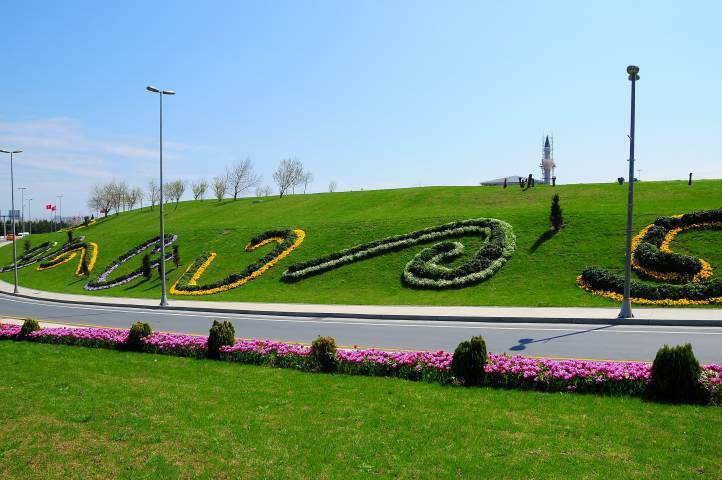Landscape Architecture for Landscape Architects › Forums › GENERAL DISCUSSION › Highway Landscape
- This topic has 1 reply, 7 voices, and was last updated 11 years, 10 months ago by
 Ozge Erdogan.
Ozge Erdogan.
-
AuthorPosts
-
February 7, 2014 at 8:03 am #153161
Deniz GÜMÜŞ
ParticipantHello my friends
i want to ask your opions about planting along the highways.
In Turkey its a new trend, everywhere full of flowers. Mostly they have different shapes and pattern. it is surrounded by roll out grass. In practical, it is very expensive to apply. As a landscape architect; i think, it’s a wrong installation type for the area. all we know about the world has serious clean water problems. why we are using a lot of water for grasses and flowers instead of using it thrifty. Grass needs good care, yes! but in future, we’ll suffer lack of clean water. Additionally I think that kind of installations (colorful flower patterns) can get distract drivers. It maybe cause accidents. What do you think about it?
February 7, 2014 at 12:07 pm #153168 Ozge ErdoganParticipant
Ozge ErdoganParticipantI agree with you…This kind of applications need more maintenance, water, etc. as you said.
February 7, 2014 at 3:06 pm #153167 Tosh KParticipant
Tosh KParticipantRather old fashioned city beautiful concept. Recently several cities in the US ran out of maintenance budget and let the grass grow – it actually looked pretty good. Downside was the increase in wildlife and therefore dead animals by the road.
February 7, 2014 at 6:00 pm #153166 Mark Di LucidoParticipant
Mark Di LucidoParticipantHi Deniz,
Here’s a photo that shows how Scottsdale (Arizona) handled beautification of freeway slopes. The designs are of southwestern U.S. plants and animals and are created entirely from colored rock.
This link http://www.scottsdalepublicart.org/permanent-art/the-path-most-trav… shows some wall treatments along the same freeway. Scottsdale gets only 18 centimeters of rain per year so minimizing water use is critical. I agree that the trend shown in your image seems extravagant, old-school, and water and maintenance intensive. Reclaimed water is an option for some landscapes but would seem to be increasingly extravagant as well.
I don’t know if the Scottsdale freeway art distracts drivers but it’s been in place since 1996. Sadly, last I heard there were plans to replace the walls (and art) with taller sound walls.
February 8, 2014 at 1:13 pm #153165 Trace OneParticipant
Trace OneParticipantIf I were you, I would follow the design process outlined in Design With Nature.
First, analyze your site as a SYSTEM – where is light and dark, slopes, soils, existing vegetation (none, probably, so then you should look at what lives naturally in this environment nearby), and the patterns of human use on the site (pretty easy – car traffic in the middle..).
Next, how does this site function in the landscape – also easy answer, it is a river (of traffic.) What do rivers look like in this area? Map the vegetation on any existing rivers, and emulate, for a nice natural design. It would be smooth stones towards the bottom of the slope, where the traffic/river runs fast and constantly, as one moves upslope you can use plants that tolerate less disturbance. Rivers are usually extremely wet and extremely dry environments – flood plains, in other words.
Once you have that mapped, feel free to abstract the plan, or overlay your stamp on it. I would stay away from color dependent landscapes, because color is so temporary and changeable, but that is my predilection.
The main point is, the more you can make your landscape look like it has a reason to look the way it does, the better the design will work. The word McHarg liked was FIT. the landscape must FIT.
and that is what I would do.
PS, don’t exclude maintenance – what machines do they use, and how will they get there? The landscape should use simple maintenance, none if possible, because highways are very dangerous places for maintenance workers. They may need access roads (unpaved) or pull-offs.
Also please try to work in bicyclists and pedestrians, safely. At least take a look at the possibility. A road is transport and cars are NOT the only type of transport humanity uses. Olmsted used braided paths, separated by grades, each type of path with dedicated uses – one path for walking, one for driving, one for horses, all three braided into the landscape.
Have fun!
And this is not to disclude the possibility of my entirely misunderstanding of your problem.
ps, as for distracting drivers, I agree with you. You do not need detail, depending on the desing speed of the road. Detail can enunciate intersections or overpasses, but on the whole, not a good idea. Try to work in broad swaths, and try NOT to irrigate anything – irrigation is high maintenance, prone to break, useless.
IMHO!
February 11, 2014 at 8:05 am #153164 Edward FlahertyParticipant
Edward FlahertyParticipantPlease consider the following regarding the planting along new highways:
First and foremost–repair the landscape that existed before the surface was ripped open. Doesn’t that make sense? It does especially if the original condition is ‘natural’.
Second–do not attempt to distract the drivers with detailed fluffiness. Driving is dangerous. Movement requires attention. Drivers should not be distracted by planting detail that is better appreciated when the viewer is not moving–that is, at rest. Doesn’t that make sense, too?
My two cents worth. Cheers.
February 11, 2014 at 6:14 pm #153163 CalicoParticipant
CalicoParticipantEverybody has made valid points regarding unnecessary ornamentation vs. needed function next to a highway (although basing the level of detail on speed should mean in my twisted world that the 405 anywhere near LAX should resemble Versailles more than a DMZ). Unfortunately, places immediately adjacent to highways tend to lack any function – ecological or otherwise – pretty much all the time, Freeway Park in Seattle notwithstanding.
Of course the photo in the original post above appears out of place given low rainfall, ostentatious given municipal budgets, unsafe to workers based on the high level of maintenance required, a waste of space that nobody outside of a car would ever want to be in, and ecologically barren compared to anything other than a golf course or water park in a desert. I could also argue just for fun that all of Scottsdale, AZ (and most of the western US, for that matter) is out of place when given its lack of precipitation and reliance upon Colorado River water… but I won’t.
The engineers in this particular instance described in the photo were most likely tasked with solving the problem of how to get as many cars as possible from point A to point B through a given area based upon a fraction of the original budget estimates required to do so. For some reason they needed to create massive cut slopes, leaving a pair of huge voids to be filled to avoid an eyesore. The landscape designer threw some whipped cream on s**t to make the best out of a bad situation, probably hoping that nobody gets killed because a bunch of flower patterns distracts a lousy driver who was most likely posting an update on Facebook while shaving anyway.
Perhaps my cynicism is showing; I have been doing quite a few streetscapes and parking lot designs recently, as they pay the mortgage quite well. (“Look, kids! There’s Daddy’s car wash landscape design!”) I like to think that without my efforts these places would be a little bit worse, although I look forward to the day that we figure out how to eliminate parking lots (and highways) generally. Admittedly, I don’t use turf except when required to do so by a municipality, as even my cheapest clients generally don’t like to pay to irrigate silly little random tree lawns in a high desert climate. But I digress.
What to do with landscape adjacent to a highway – or a street, for that matter – stems from value questions that are much older than our profession. These get at the heart of landscape architecture: Is design for the sake of aesthetics truly necessary? Should we read The Fountainhead again to remind ourselves of how Howard Roark would fix Peter Keating’s fluffy highway landscape design to win an award?
February 12, 2014 at 12:25 am #153162 Trace OneParticipant
Trace OneParticipantI forgot to mention EROSION CONTROL. You are responsible that the landscape does not fall onto thehighway. I have no idea of wind, soil, or water conditions where you live, but EVEN Howard Roark would approve of a design based on EROSION CONTROL.
-
AuthorPosts
- You must be logged in to reply to this topic.



